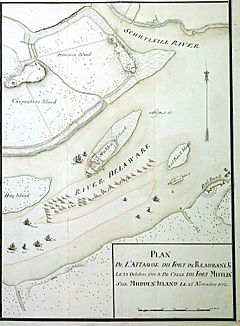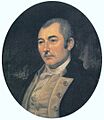Siege of Fort Mifflin facts for kids
Quick facts for kids Siege of Fort Mifflin |
|||||||
|---|---|---|---|---|---|---|---|
| Part of the Philadelphia campaign of the American Revolutionary War | |||||||
 Hessian Map of the forts at Mud Island and Red Bank |
|||||||
|
|||||||
| Belligerents | |||||||
| Commanders and leaders | |||||||
|
|
|
||||||
| Strength | |||||||
| 2,000 troops, naval squadron | 450 & reinforcements river flotilla |
||||||
| Casualties and losses | |||||||
| 58 captured, over 62 killed HMS Augusta (64) sunk HMS Merlin (18) sunk |
250 killed and wounded entire river flotilla scuttled |
||||||
The Siege of Fort Mifflin was an important event during the American Revolutionary War. It took place from September 26 to November 16, 1777. British forces, led by Captain John Montresor and Vice Admiral Lord Richard Howe, tried to capture an American fort on the Delaware River. This fort, called Fort Mifflin, was commanded by Lieutenant Colonel Samuel Smith.
The British army, led by General Sir William Howe, had taken over Philadelphia, Pennsylvania on September 26, 1777. They needed a way to get supplies to their troops. Fort Mifflin, located on Mud Island in the Delaware River, and Fort Mercer in Red Bank, New Jersey, blocked the river. These forts, along with underwater obstacles and a small American fleet, stopped the British Navy from bringing supplies into Philadelphia.
Because Philadelphia was blocked, the British had to capture Fort Mifflin to open the river. A Hessian attack on Fort Mercer failed on October 22. The next day, two British warships got stuck near Mud Island and were destroyed. Even though General George Washington sent more soldiers, Fort Mifflin never had more than 500 defenders. The British finally gathered enough cannons and warships to attack Fort Mifflin heavily starting on November 10. The American soldiers could no longer fight back. Major Simeon Thayer, who took command after Smith was wounded, ordered the remaining soldiers to leave the fort on the night of November 15. The British took over the fort the next morning. Soon after, Fort Mercer was also abandoned, which opened the Delaware River for the British. This allowed them to hold Philadelphia until June 1778.
Contents
Why Fort Mifflin Was Important
The Fight for Philadelphia
After the British won the Battle of Brandywine on September 11, 1777, they moved towards Philadelphia, Pennsylvania. Philadelphia was a very important city for the Americans. On September 26, the British army took control of Philadelphia. The Second Continental Congress, which was the American government, had to leave the city.
Building River Defenses
To protect Philadelphia from British ships, the Americans built defenses on the Delaware River. One of these was the fort on Mud Island, which later became Fort Mifflin. This fort was designed by a British engineer, John Montresor, in 1771. After the war started, the Americans finished building the fort. They used wooden fences and dirt walls to make it stronger.
The fort had many cannons to guard the river. There were also sharp logs around the fort and "wolf holes" (hidden pits with sharp stakes) to stop attackers. Large underwater obstacles called chevaux de frise were placed in the river. These had iron-tipped stakes that could rip holes in the bottom of enemy ships.
The Siege Begins
Getting Ready for Battle
At first, Colonel Lewis Nicola and some Pennsylvania militia held Fort Mifflin. But these soldiers did not know how to use the cannons. On September 23, 1777, General Washington sent Lieutenant Colonel Samuel Smith and 200 soldiers from the Continental Army to Fort Mifflin. They had to travel a long way to reach the fort. They were helped by the Pennsylvania Navy fleet, led by Commodore John Hazelwood.
Washington wanted a Prussian officer, Baron Henry Leonard d'Arendt, to command the fort. But the baron was too sick, so Smith became the leader. Later, another officer, Lieutenant Colonel John Green, arrived with more soldiers. Smith and Hazelwood did not always agree, which made things harder. On October 4, Washington's army attacked the British at the Battle of Germantown but lost.
Early Attacks and Defenses
To make it harder for the British, the Americans broke the walls along the riverbanks. This flooded the land, forcing the British to build their cannon positions in deep water. On October 10, British crews began building a cannon battery on Carpenter's Island, across from the fort.
The next day, Hazelwood and Smith attacked the British workers with their boats. They captured 58 British soldiers. This was a setback for the British. On October 14, a French engineer, Major François-Louis Teissèdre de Fleury, arrived at the fort. He helped Smith improve the defenses. He built new firing positions and a strong point in the middle of the fort.
Big Battles and Disasters
Battle of Red Bank
On October 22, a German force called Hessians, led by Colonel Carl von Donop, attacked Fort Mercer. This fort was on the New Jersey side of the river. Colonel Christopher Greene and his 1st Rhode Island Regiment defended Fort Mercer. Major Simeon Thayer and 150 soldiers from Fort Mifflin went to help.
The Hessians attacked, but the Rhode Island soldiers waited until they were very close before firing. The Hessians suffered heavy losses. The Americans lost only 14 killed, while the Hessians lost 90 killed and many more wounded or captured. Colonel Donop was badly wounded.
The next day, October 23, was another bad day for the British. A group of British warships, led by Captain Francis Reynolds, moved up the river to help attack Fort Mercer. The ships included the large HMS Augusta (64 cannons) and the smaller HMS Merlin (18 cannons).
While firing at Fort Mifflin, Augusta and Merlin got stuck in the mud. The tide came in, but strong winds kept them stuck. On October 23, the American forts fired at the two trapped ships. The British tried to rescue Augusta, but it caught fire. The Americans said a hot cannonball from Fort Mifflin or a fire ship started the fire. At midday, Augusta exploded with a huge blast that broke windows in Philadelphia. About 60 sailors died. After Augusta exploded, the crew of Merlin set their ship on fire and left it. Merlin also exploded, but not as loudly.
The Final Attack
Storm and Blockade
Starting on October 26, a big storm hit the area for three days. It brought strong winds and heavy rain. Most of Mud Island and the nearby islands were covered in two feet of water. Both sides stopped fighting and tried to find dry ground. By November 1, the Americans had successfully blocked the British army in Philadelphia. The British troops were running low on food, drinks, clothes, and money.
The British had to send supplies to Philadelphia using flatboats at night. They had to be very quiet to avoid being sunk by the cannons of Fort Mifflin and the American ships.
Heavy Bombardment
On November 10, the British were finally ready to destroy Fort Mifflin. They had many large cannons, including 32-pounders and 24-pounders, and large mortars. They fired at the fort from about 500 yards away. The Americans did not lose anyone that day, but large parts of the fort's wooden walls were destroyed.
On November 11, Captain Treat was killed by the force of a cannonball that landed nearby. Later that day, a cannonball hit the chimney of the barracks where Smith was. It hit him in the hip, but he survived because the cannonball had lost most of its power.
Leadership Changes and Last Stand
The wounded Smith was taken to Red Bank, leaving the fort without a leader. Major Simeon Thayer took command on November 12. He wrote to Washington that the soldiers could fix the damage to the fort every night. The only safe place was a ditch on the east side.
On November 15, the British brought a special ship called HMS Vigilant (20 cannons) to attack the fort. This ship was designed to fire at forts. It moved into the shallow water very close to Fort Mifflin, only 20 yards away. Other British warships also fired from farther away.
Fort Mifflin was hit by a terrible barrage of cannon fire. One shot killed five American gunners at a single cannon. Thayer tried to signal for help from Hazelwood, but the fort's flag had to be lowered first. When the British saw the flag go down, they cheered, thinking the Americans were surrendering. Thayer's officers quickly demanded the flag be raised again. The fighting continued. Later that day, a piece of wood from the destroyed barracks hit Captain James Lee and knocked Fleury unconscious.
General Howe decided not to send his soldiers to attack the fort directly, hoping the Americans would leave. That evening, around 11:30 PM, Thayer ordered the remaining 300 survivors to abandon Fort Mifflin. They rowed across to Red Bank. Thayer stayed with 40 men to burn the barracks at midnight, then he was the last to leave.
After the Siege
At 6:00 AM on November 16, British marines landed at Fort Mifflin and took down the American flag, which had been left flying. Two hours later, British troops took over the ruined fort. They found one American soldier who had stayed behind. He told them that about 50 American soldiers were killed and 70 to 80 were wounded during the siege. The British officers admired the bravery of the American defenders.
On November 17, Lieutenant General Lord Charles Cornwallis crossed the river with 2,000 men to attack Fort Mercer. Colonel Greene and his men left Fort Mercer before Cornwallis arrived, so the British took it without a fight on November 20. With both forts gone, Commodore Hazelwood set his American ships on fire that night so the British could not capture them. The Delaware River was now open for the British Navy to bring supplies to Philadelphia.
Images for kids










